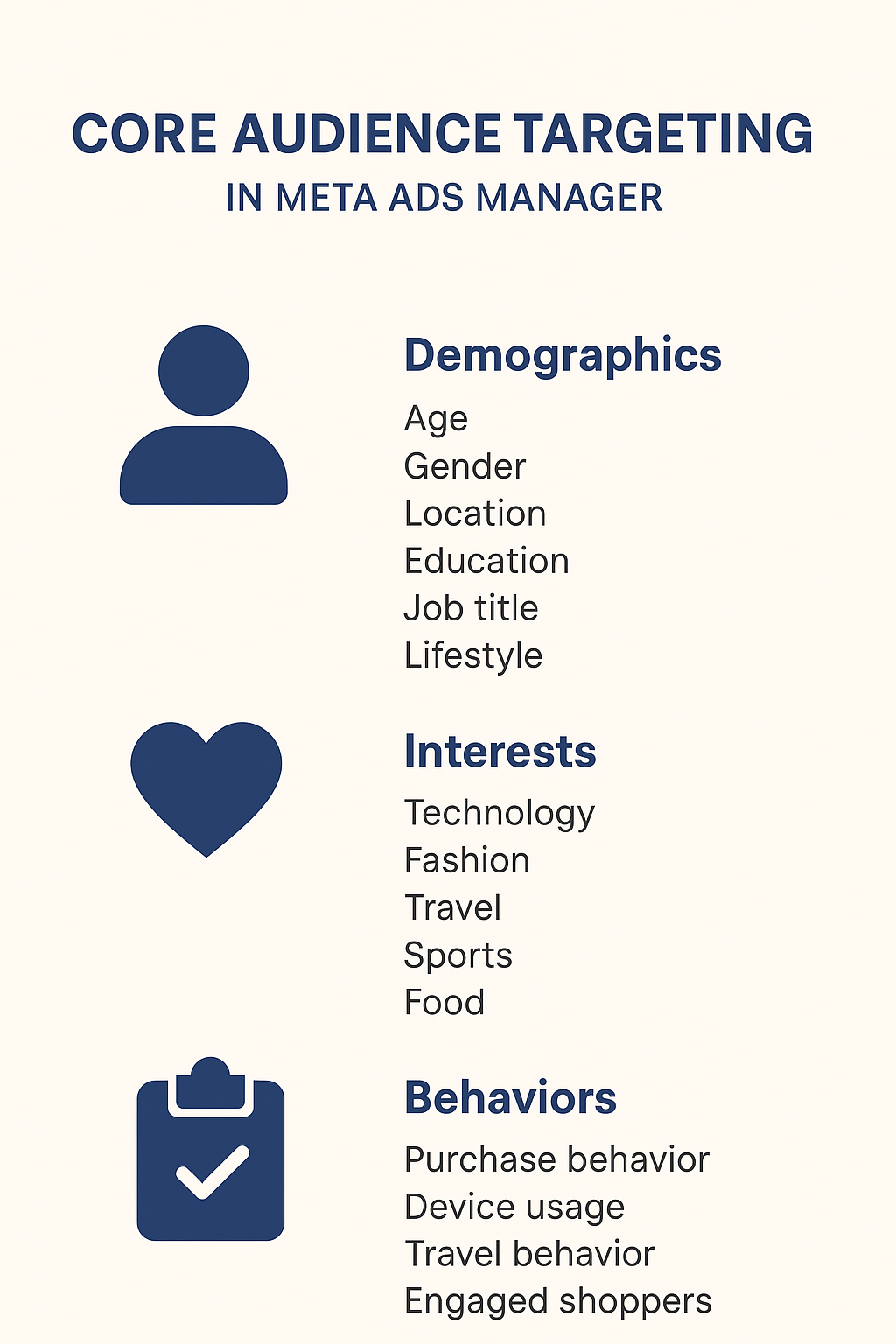Introduction
In today’s digital-first world, businesses can’t afford to waste money showing ads to the wrong people. Meta Ads Manager (the platform behind Facebook and Instagram advertising) provides some of the most advanced targeting tools available to marketers. At the heart of these tools lies Core Audience Targeting—a method that allows advertisers to carefully define who should see their ads based on demographics, interests, and behaviors.
Unlike Custom Audiences (which focus on people who already know your brand) or Lookalike Audiences (which find “similar” people to your best customers), Core Audiences are about reaching new potential customers who fit your ideal profile. This makes it an essential strategy for awareness campaigns, product launches, or businesses entering new markets.
1: Demographic Targeting
Demographics are the backbone of Core Audience Targeting. They allow advertisers to define audiences based on who they are.
Key Options for Demographic Targeting:
-
Age & Gender
-
Narrow your audience to specific age groups or genders.
-
Example: A skincare brand targeting women aged 25–40.
-
-
Location
-
Target by country, state, city, or even by dropping a pin on the map.
-
Radius targeting (e.g., within 5 km of a store) helps local businesses.
-
-
Education
-
Students, graduates, fields of study, or education levels.
-
Example: An edtech company targeting university students studying engineering.
-
-
Job Title & Industry
-
Excellent for B2B campaigns.
-
Example: A software company advertising to IT managers or HR professionals.
-
-
Relationship Status & Life Events
-
Single, married, engaged, newly moved, new parents, or birthdays.
-
Example: A jewelry brand targeting recently engaged women.
-
2: Interest Targeting
Meta knows what users are interested in, thanks to their activities—what pages they like, posts they engage with, videos they watch, and ads they click. Advertisers can leverage this data to reach people based on their interests.
Common Interest Categories:
-
Technology & Gadgets
-
Mobile phones, laptops, AI, apps, or software.
-
Perfect for electronics retailers or SaaS providers.
-
-
Fashion & Beauty
-
Clothing brands, fashion magazines, influencers, skincare, makeup.
-
Example: A new beauty brand targeting fashion-conscious women.
-
-
Travel
-
Frequent travelers, adventure lovers, family vacations.
-
Example: A travel agency promoting summer packages.
-
-
Sports & Fitness
-
Football, cricket, gyms, yoga, health apps.
-
Example: A fitness brand advertising protein supplements.
-
-
Food & Drink
-
Restaurants, healthy eating, vegan recipes, fast food lovers.
-
Example: A food delivery app targeting late-night eaters.
-
3: Behavior Targeting
While interests tell us what people like, behaviors show what they actually do. Behavior targeting is extremely powerful because it uses real-world actions rather than assumptions.
Examples of Behavior Targeting:
-
Purchase Behavior
-
Online buyers, frequent shoppers, luxury buyers.
-
Example: An e-commerce brand targeting people who recently purchased fashion items.
-
-
Device Usage
-
Android vs. iOS, desktop vs. mobile, or even specific device models.
-
Example: A mobile app company targeting only iOS users.
-
-
Travel Behavior
-
Frequent flyers, international travelers, business travelers.
-
Example: A luggage brand targeting frequent international travelers.
-
-
Digital Activities
-
People who often click “Shop Now” ads (engaged shoppers).
-
Example: A new D2C clothing store advertising to “engaged shoppers.”
-
4: Why Core Audiences Matter + Example
Benefits of Core Audience Targeting:
-
Reach new people who don’t know your brand yet.
-
Laser-focused targeting reduces wasted ad spend.
-
Flexibility—you can mix and match demographics, interests, and behaviors.
-
Scalability—use Core Audiences to test markets before creating Lookalike Audiences.
Example: Cyber Café in Bangalore
Reach new people who don’t know your brand yet.
Laser-focused targeting reduces wasted ad spend.
Flexibility—you can mix and match demographics, interests, and behaviors.
Scalability—use Core Audiences to test markets before creating Lookalike Audiences.
A cyber café looking to attract students and gamers could build a Core Audience like this:
-
Location: Bangalore, 10 km radius.
-
Age: 18–30 years.
-
Interests: Gaming, eSports, online learning, internet browsing.
-
Behaviors: Mobile gamers, frequent app installers, engaged shoppers.
Conclusion
Core Audience Targeting in Meta Ads Manager is not just a feature—it’s the foundation of successful advertising on Facebook and Instagram. By carefully defining audiences through demographics, interests, and behaviors, businesses can ensure their ads are reaching the right people at the right time.
Unlike random or broad advertising, Core Audiences provide precision. They allow small businesses and large brands alike to filter audiences based on age, gender, education, profession, lifestyle, passions, and even purchase behavior. This means every dollar spent on ads works harder, minimizing waste while maximizing conversions.
For businesses just starting with Meta Ads, Core Audience Targeting is the first step to discovering who responds best to their products or services. For established advertisers, it serves as a reliable way to test new markets, launch new products, or complement Custom and Lookalike Audiences.